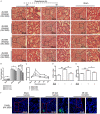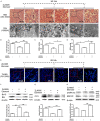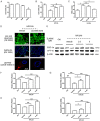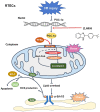ZLN005 protects against ischemia-reperfusion-induced kidney injury by mitigating oxidative stress through the restoration of mitochondrial fatty acid oxidation
- PMID: 34650679
- PMCID: PMC8507071
ZLN005 protects against ischemia-reperfusion-induced kidney injury by mitigating oxidative stress through the restoration of mitochondrial fatty acid oxidation
Abstract
To date, the treatment of acute kidney injury (AKI) remains a difficult problem for clinicians. In the present study, we assessed whether ZLN005, a novel peroxisome proliferator-activated receptor-γ coactivator-1α (PGC-1α) agonist, can protect against ischemic AKI in vivo and in vitro. Notably, ZLN005 treatment significantly alleviated Ischemia-reperfusion (I/R)-induced tubular injury and reversed the decrease in hypoxia-reoxygenation-induced cell viability by restoring PGC-1α expression in a dose-dependent manner. This beneficial effect of ZLN005 was associated with the preservation of mitochondrial fatty acid oxidation (MitoFAO) and the alleviation of oxidative stress. Cotreatment with etomoxir, a specific inhibitor of carnitine palmitoyltransferase-1α (CPT-1α) activity, or CPT-1α siRNA abrogated ZLN005-induced antistress responses by mitigating reactive oxygen species production and decreasing apoptosis under ischemia-hypoxia conditions by suppressing MitoFAO. Further studies revealed that activation of endoplasmic reticulum (ER) stress may be involved in the effect of CPT-1α inhibition observed in vivo and in vitro. Collectively, our results suggest that ZLN005 confers a protective effect on I/R-induced kidney injury by mitigating ER stress through the restoration of MitoFAO by targeting PGC-1α.
Keywords: Acute kidney injury; ZLN005; apoptosis; carnitine palmitoyl transferase-1α; oxidative stress; peroxisome proliferator-activated receptor-γ coactivator-1α.
AJTR Copyright © 2021.
Conflict of interest statement
None.
Figures










Similar articles
-
ZLN005 Alleviates In Vivo and In Vitro Renal Fibrosis via PGC-1α-Mediated Mitochondrial Homeostasis.Pharmaceuticals (Basel). 2022 Mar 31;15(4):434. doi: 10.3390/ph15040434. Pharmaceuticals (Basel). 2022. PMID: 35455432 Free PMC article.
-
The PGC-1α Activator ZLN005 Ameliorates Ischemia-Induced Neuronal Injury In Vitro and In Vivo.Cell Mol Neurobiol. 2018 May;38(4):929-939. doi: 10.1007/s10571-017-0567-0. Epub 2017 Nov 20. Cell Mol Neurobiol. 2018. PMID: 29159732 Free PMC article.
-
PGC-1α alleviates mitochondrial dysfunction via TFEB-mediated autophagy in cisplatin-induced acute kidney injury.Aging (Albany NY). 2021 Mar 10;13(6):8421-8439. doi: 10.18632/aging.202653. Epub 2021 Mar 10. Aging (Albany NY). 2021. PMID: 33714196 Free PMC article.
-
The Role of PGC-1α and Mitochondrial Biogenesis in Kidney Diseases.Biomolecules. 2020 Feb 24;10(2):347. doi: 10.3390/biom10020347. Biomolecules. 2020. PMID: 32102312 Free PMC article. Review.
-
Tubular Mitochondrial Dysfunction, Oxidative Stress, and Progression of Chronic Kidney Disease.Antioxidants (Basel). 2022 Jul 12;11(7):1356. doi: 10.3390/antiox11071356. Antioxidants (Basel). 2022. PMID: 35883847 Free PMC article. Review.
Cited by
-
Energy metabolic reprogramming regulates programmed cell death of renal tubular epithelial cells and might serve as a new therapeutic target for acute kidney injury.Front Cell Dev Biol. 2023 Nov 20;11:1276217. doi: 10.3389/fcell.2023.1276217. eCollection 2023. Front Cell Dev Biol. 2023. PMID: 38054182 Free PMC article. Review.
-
ZLN005 Alleviates In Vivo and In Vitro Renal Fibrosis via PGC-1α-Mediated Mitochondrial Homeostasis.Pharmaceuticals (Basel). 2022 Mar 31;15(4):434. doi: 10.3390/ph15040434. Pharmaceuticals (Basel). 2022. PMID: 35455432 Free PMC article.
-
Peroxisome Proliferator-Activated Receptor-γ Coactivator-1α in the Spotlight with Multiple Sclerosis.Neurosci Bull. 2024 Feb;40(2):268-272. doi: 10.1007/s12264-023-01114-w. Epub 2023 Sep 16. Neurosci Bull. 2024. PMID: 37715922 Free PMC article. No abstract available.
-
Targeting mitochondrial quality control: new therapeutic strategies for major diseases.Mil Med Res. 2024 Aug 21;11(1):59. doi: 10.1186/s40779-024-00556-1. Mil Med Res. 2024. PMID: 39164792 Free PMC article. Review.
-
MondoA and AKI and AKI-to-CKD Transition.J Am Soc Nephrol. 2024 Sep 1;35(9):1164-1182. doi: 10.1681/ASN.0000000000000414. Epub 2024 May 31. J Am Soc Nephrol. 2024. PMID: 38819935 Free PMC article.
References
-
- Bellomo R, Kellum JA, Ronco C. Acute kidney injury. Lancet. 2012;380:756–766. - PubMed
-
- Liao W, Fu Z, Zou Y, Wen D, Ma H, Zhou F, Chen Y, Zhang M, Zhang W. MicroRNA-140-5p attenuated oxidative stress in cisplatin induced acute kidney injury by activating Nrf2/ARE pathway through a Keap1-independent mechanism. Exp Cell Res. 2017;360:292–302. - PubMed
LinkOut - more resources
Full Text Sources
